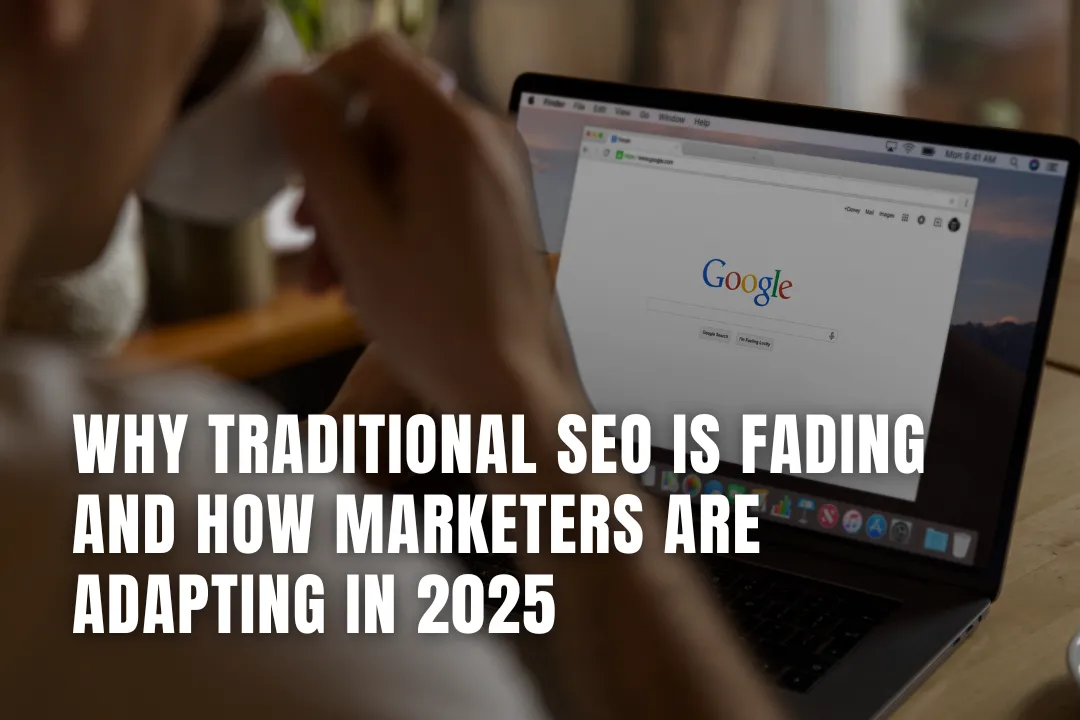
SEO isn’t dead, but it’s evolving. Tactics like keyword stuffing, link-chasing, and traffic-at-any-cost are losing their punch. Search engines and users alike are demanding more.
Today’s users want helpful, relevant, and personalized content, not pages that simply game the algorithm. As traditional SEO tactics fade, smart businesses are shifting toward strategies rooted in user intent, topic authority, and AI visibility.
In this article, we’ll explore why traditional SEO is losing ground and what innovative marketers are doing instead.

Traditional SEO isn’t “dying”, it’s being outgrown. Old tactics like keyword stuffing, link farms, and basic meta optimization don’t move the needle anymore. Google’s search algorithms have evolved, and user expectations have changed.
In fact, Zero-click searches now account for 57% of all Google activity. This means users are getting answers without even clicking through. Ranking for visibility alone, without value, just isn’t enough.
The way people search online isn’t what it used to be, and modern marketers are feeling it. We’ve moved from typing keywords into Google to asking full questions across multiple platforms, including AI tools like ChatGPT and Gemini.
Search isn’t just about matching words anymore. It’s about understanding intent; what someone wants to know, do, or decide. And it’s not linear. A person might start with a voice search, follow up with a blog on mobile, and ask ChatGPT for a comparison later that night.

So, what actually works now? Let’s break it down.
In 2025, sustainable SEO should focus on becoming the trusted source on the topics your audience cares about. Search engines and AI tools now prioritize content that shows depth, relevance, and real-world expertise.
Instead of isolated blog posts, marketers are building interconnected content ecosystems (think guides, FAQs, case studies, and expert explainers) that work together to answer related questions and support the full customer journey.
When you structure content this way, you signal to Google and generative AI tools that your brand is a reliable authority in your space. That makes it easier to rank for long-tail and conversational queries, especially those based on voice or natural language.
For brands focused on retail, mobility, or location-based engagement, this kind of depth also helps build relevance with local audiences, especially when paired with data-backed insights and behavioral signals.
If you’re not sure what generative engine optimization (GEO) is, you’re not alone. GEO is quickly becoming the next frontier in search. It’s less about ranking on Google’s first page and more about being the trusted source that AI tools like ChatGPT, Gemini, and Perplexity pull answers from.
The goal is simple: make your content easy for AI to find, understand, and trust, so when users ask a question, your brand’s expertise comes through. Forward-thinking agencies, like Skale, are already helping marketers prepare for this shift. While the mindset shift might seem big, the practical steps are straightforward.
Here’s how to get started:
Optimizing for user intent means aligning your content with what your audience wants to do when they search. To do this, you need to first start by categorizing the keyword or topic into one of four core intent types:
For informational intent, answer the main question within the first 100 words. Then build out supportive content (like FAQs, visuals, or examples) to boost user satisfaction and improve your chances for featured snippets.
Google signals search intent through features like Featured Snippets, People Also Ask, product carousels, and local map packs. Use clear headings, lists, and schema markup to help your content appear in these prominent spots.
Finally, it’s essential to monitor engagement metrics such as bounce rates and click-through rates (CTR) with analytics tools. If visitors are leaving quickly, your content might not match their intent, and that’s your cue to refine your intros and page layout based on real user behavior.
In 2025, broad, one-size-fits-all SEO strategies just don’t cut it anymore. Real, sustainable growth comes from local and niche SEO, especially for brands serving specific regions or specialized markets.
If your brand targets a particular location or community, start by optimizing your Google Business Profile, using geo-targeted keywords, and securing listings in relevant local and industry directories.
For niche SEO, focus on creating content around the specific, lower-competition search terms your audience uses. These keywords may drive less traffic overall but attract highly qualified leads.
Tailoring your content and visibility efforts this way builds deeper trust, relevance, and long-term ranking strength with your core audiences. To understand competitiveness and uncover new opportunities, keyword tools like Semrush are invaluable.
Around 20.5% of people worldwide are actively using voice search. The key thing to remember? People don’t talk like they type. Voice queries are more conversational and question-driven, like “What’s the best sushi place near me right now?” or “How do I fix a leaking faucet?”
To optimize for voice search, structure your content to answer these questions directly and naturally. Use conversational language, include featured snippet-friendly formatting, and add FAQ sections that cover common queries. Incorporate long-tail keywords that reflect how people speak, and aim for clear, concise, authoritative answers that voice assistants can easily pull from.
Beyond content, technical SEO matters more than ever. Ensure your website loads quickly, is mobile-friendly, and includes local schema markup. These foundational elements help voice assistants discover and rank your content, especially for location-based queries critical to retail, hospitality, and mobility brands.
As third-party cookies disappear, the data you collect directly from your customers, called first-party data, has become more valuable than ever. It’s more accurate, respects privacy, and helps you create personalized experiences that feel relevant.
Pair that with Conversion Rate Optimization (CRO), and you’re making the most of the traffic you already have. Use your data to break your audience into meaningful groups, test different landing pages, tweak calls-to-action, and smooth out the user journey so more people take the actions you want.

While SEO has evolved so much from years ago and from when it first emerged, many practices still remain essential and drive results when they’re used strategically:
Google also continues to reward E-E-A-T (Experience, Expertise, Authoritativeness, Trustworthiness). Showcase expert authors, cite reliable sources, and build trust through transparency and quality.
Traditional SEO isn’t what it used to be. Marketers who rely on outdated tactics like keyword stuffing, spammy link-building, or thin content are quickly falling behind. Today’s search engines and users care much more about real value, authentic experience, and true user intent.
The smartest marketers are adapting by focusing on what works in 2025: creating people-first content, building strong topic authority, leveraging first-party data, and optimizing for AI-powered and voice search. They’re no longer just chasing rankings; they’re building trust, improving user experiences, and attracting traffic that truly converts.
The future of SEO is smarter; it rewards strategic, thoughtful approaches. To stay ahead, marketers need to ditch the old playbook and start building systems that align with how people really search and how modern algorithms understand content.